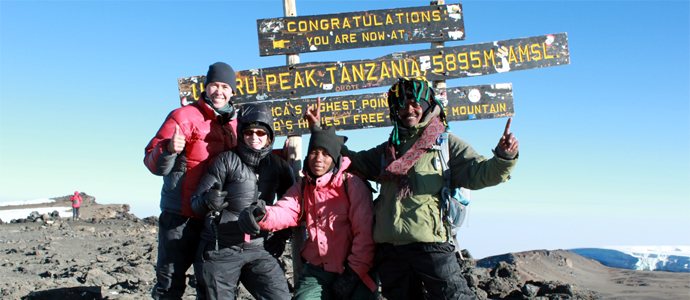
Mount Kilimanjaro Climb Review
Tanzania, August 2010
Kilimanjaro Climb – Day 1: Machame Gate to Machame Huts
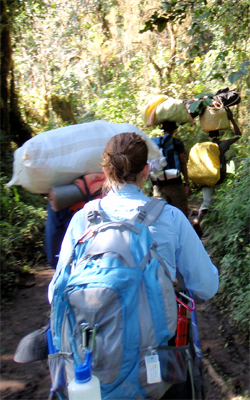 The trip started off a little rough with Debbie throwing up both on the plane and on the drive to the mountain. We suspected the unusually high 500mg dosage of Diamox that her doctor had prescribed. We decided early on to switch so she could use my 250mg pills. When we reached the Machame gate where our journey would start, we sat around for a while with other visitors waiting for our lead guide, Mark, to complete the paperwork. The trip started off a little rough with Debbie throwing up both on the plane and on the drive to the mountain. We suspected the unusually high 500mg dosage of Diamox that her doctor had prescribed. We decided early on to switch so she could use my 250mg pills. When we reached the Machame gate where our journey would start, we sat around for a while with other visitors waiting for our lead guide, Mark, to complete the paperwork.
Eventually, Mark decided to send us along on the trail with a porter named Richard while he completed those formalities. Richard was fairly young and knew little English so we were really only able to exchange a few pleasantries but he was friendly enough. Eventually, our assistant guide, Pascal, caught up with us who spoke better English and was able to give us a little more information about the climb. Though we knew we had a large group supporting us on our trip, we rarely saw the entire group together. In total, we had a head guide, assistant guide, a cook and six porters who would help us along our path to the rooftop of Africa.
Our pace with Richard and Pascal was probably a littler faster than it should have been and we didn't stop for lunch until after 2pm. Since our breakfast had been rushed at 7am, the late lunch didn't make this starting portion of the climb any easier for us. Mark caught up with us as we ate our box lunch of chicken, a muffin, a banana, chips, juice, cookies and fudge.
After lunch, we continued the trek through the forest hearing the occasional monkey but never seeing any of them. Even in the rainforest section of the climb, the bugs were never a problem and were really only noticeable when we stopped for lunch. This was a relief because we had been expecting the worst and had even resorted to treating our clothes with a pretty intense repellant.
With Mark taking the lead, we settled into a pace we were more comfortable with, reminding us that we should move “pole, pole” or “slowly, slowly.” This leg of the trip was just under 12km with an altitude gain of about 1200m and with the pace we maintained, it was hard work. We arrived at the camp and signed in at the registration hut. Camp was set up in an extremely dusty forested area with lots of Old Man's Beard hanging from the trees.
We were given water to wash, popcorn, cookies and water for tea or hot chocolate. The sun set around 6:30pm and we ate dinner about an hour after that. We started with a cucumber soup and bread. Not knowing that there was more to come we ate quite a bit only to be greeted with several more courses. The food was all quite good and after eating we went straight to sleep.

Kilimanjaro Climb – Day 2: Machame Huts to Shira Caves
The trip from the Machame huts to Shira caves was a much shorter hike than the previous day. Much of the trail was as dusty as the Machame Huts campsite. The trail ascended steadily through some rocky terrain. I was pretty comfortable on the rocks since it seemed to use different leg muscles than the previous day's trail. Debbie, however, felt a little misled by the guidebook's claim that this was the easiest day. As we got closer to camp, I kept myself busy looking for nice pieces of obsidian. By this point, there were already times when we were looking down on the clouds which is an odd feeling. We had some good views of the peak but it looked so far away.
The Shira caves campsite had a very different terrain than the last one. There were no more trees, only low, sparse bushes called groundsel. There were also large boulders of volcanic rock scattered around. There was little protection from the wind and during bad weather I would imagine it would be a pretty inhospitable place.
Once at camp, my legs still felt pretty fresh which seemed to be a good sign. The next portion of the climb promised to be a long one so it was good that we would be well rested. By this point, we had already begun to look forward to hearing Pascal tell us he had brought us water to wash. Though we never really got that clean, it was refreshing to rinse off some of that day's dust.
In the middle of the night, I started having stomach problems from the 500mg dose of Diamox. A 4am trip to the “choo” became a bit of an adventure. The darkness of night on an African mountain is fundamentally different than nighttime of the Chicago suburbs. While the stars were plentiful, it wasn't enough to shed any light on the trail and my headlight suddenly seemed woefully inadequate as I tried to make my way back to the tent. The trail was very faint – it was truly just an area with slightly less groundsel. There were also many different routes and boulders began looking very much like tents. I circled through a different campsite then ran into a bit of a gully that didn't seem familiar from earlier in the day. Eventually, I reached a point where I couldn't find out campsite and I could no longer retrace my steps back to the bathroom I had visited. I knew that I needed to be resting instead of wandering around and the night air was getting increasingly cold. After about 25 minutes, I was relieved to find our campsite again. It was a LONG 25 minutes....

Kilimanjaro Climb – Day 3: Shira Caves to Barranco Huts
We woke to what sounded like boomerangs being thrown around out tent. I peered out of the tent to see a number of really larger birds flying around camp looking for scraps. It was really the only wildlife we saw through the entire climb. As we started the day (always quite a bit later than we planned) some of my confidence after the previous day's hike had slipped away after the night's stomach problems. It felt like once we made it through this portion of the hike, we would be home free until the summit night.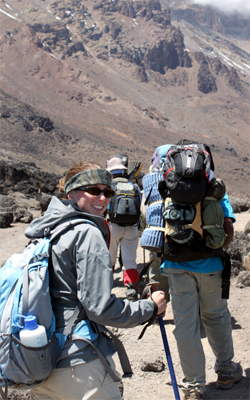 The day's agenda was broken into two sections – uphill to Lava Tower (6km) then back downhill to Barranco Huts (5km). After running and hiking so much during training, the distance covered seemed so trivial but with the altitude and the sometimes rough terrain it was a challenging journey. The day's agenda was broken into two sections – uphill to Lava Tower (6km) then back downhill to Barranco Huts (5km). After running and hiking so much during training, the distance covered seemed so trivial but with the altitude and the sometimes rough terrain it was a challenging journey.
By this point, I had really learned to love my trekking poles and they were definitely worth the $15 to rent. I found myself really driving them down and behind me to take some of the strain off my legs. We stopped a bit for a hot lunch prepared by Edie at a spot just before we reached Lava Tower. This meal was out in the open since the tent we usually ate in wasn't set up. Though reducing Debbie's Diamox dose had her feeling better, her appetite was still pretty light. I normally tried to eat extra so that we didn't seem ungrateful by sending back a bunch of untouched food. Edie's food was excellent, but there was also a lot of it. This time, neither of us were able to dig into the chicken they had prepared for us and it happened to be the only time we were sitting there in the open with him watching us eat.
At this point, we decided that 500mg Diamox pills are not fit for human consumption but should be reserved for mountain climbing horses. We had enough of the 250mg pills to get us both to the top so we decided to go that route and make the decent without the mediation.
Once finished lunch, we passed Lava Tower and began the downhill portion of the day's trek. We had hoped moving downhill would be easier but Debbie was a little hesitant on the rocks. It's certainly better to be safe than sorry but it also takes quite a bit more energy to stop and stabilize your weight instead of just hopping to the next step. We seemed to be dragging behind Mark's pace and it took us over an hour longer to reach camp than he had estimated.
One other miscalculation during this stretch of the trek was that we didn't make sure one of our extra water bottles was filled before we set out. I was getting pretty low on water by Lava Tower and didn't drink enough on the way down. Staying hydrated is critical – especially when acclimating to the altitude so making sure bottles are filled is important.
The Barranco Huts campsite was really a beautiful site with a stream cutting through it. Because of the stream, it was a pretty lush area compared to the rocky terrain we had been passing through. By the time we reached the camp, Debbie and I were both too tired to appreciate it. My legs were just starting to get a little shaky by the end but with two short days ahead before summit night, we knew we should have a chance to recover. Debbie had developed a bit of a blister and we asked Mark if he had any advice but I'm not sure he totally understood what we were asking and didn't give us a lot of guidance. Thankfully, it didn't cause any real problems for the rest of the climb.
I felt bad that we haven't spent more time with the crew. We tend to get into our tent to change and rest right away. The door is usually closed because of the cold. At these later camps, just being outside and exposed to the elements seems taxing. Hopefully, they understood.
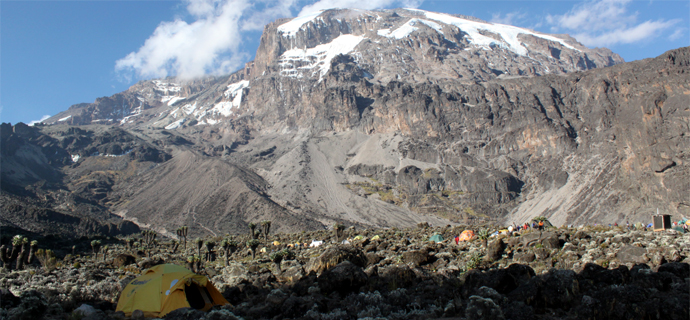
Kilimanjaro Climb – Day 4: Barranco Huts to Karanga Valley
Despite the relatively taxing day hiking to the Barranco Huts, we woke up fairly fresh and excited to tackle the Barranco Wall. Since the day's hike wasn't going to be long, we started out even later than usual. This helped us avoid a lot of the traffic jam on the wall. With our trekking poles tucked away so we could have both hands free, we began to make our way up the steep path. It was amazing watching the porters effortlessly climb the wall with heavy payloads balanced on their heads. While climbing the wall was strenuous, it was a nice change of pace after many days of straight walking.
After reaching the top, we crossed a couple hills before descending into Karanga Valley. The stream in this valley is the last water before the summit so before we left camp, the porters collected about 40 liters of water to take to the next camp. The Karanga Valley camp was actually on an exposed rocky slope just passed the valley itself. There were excellent views of the peak and at night the bright lights of Moshi town were clear in the distance.
Since we got in early, I took some time to shave and try out the no-rinse shampoo and soaps that we had packed. They did help refresh a bit but couldn't make much of a dent in the accumulated grime. The steep slope made trips to the bathroom a chore. The options were to walk straight down then climb back up (tiring) or walk laterally along the uneven slope (awkward). It also meant our sleeping bags had a tendency to constantly slip down.
The night got cold quickly once the sun set but the tents kept the wind out and my very inexpensive sleeping bag was holding up well. Though we had read about people layering lots of clothing by this point, sleeping in fleece pants and a long sleeve shirt seemed entirely adequate. Despite the rocky slope, we were comfortable with both the supplied foam mats and the Thermarest camp mats we brought with us. According to Mark, the hike to the Barafu base camp would just be a hour and a half but we had been overshooting his estimates.
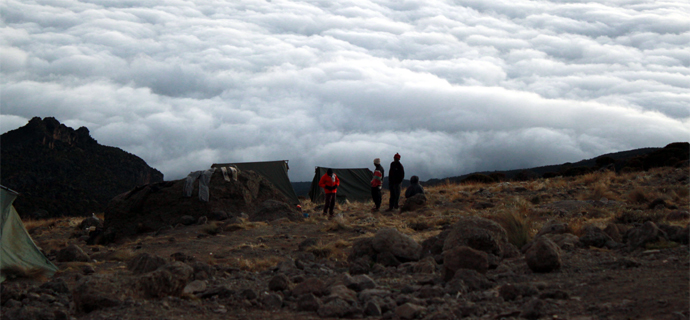
Kilimanjaro Climb – Day 5: Karanga Valley Camp to Barafu Huts
The path from Karanga to Barafu was a pretty steady and, while the day was short, it was certainly longer than an hour and a half. 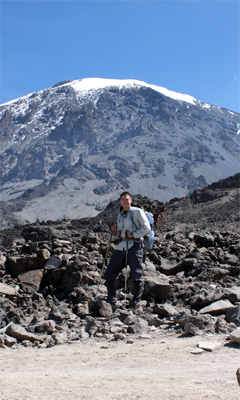 Some treks actually skipped the stop at Karanga Valley and proceed straight to Barafu but we were glad we opted for the extra day before the challenging summit night. We had heard about the benefits of doing the Machame route in seven days instead of six to aid acclimatization. After making the hike, it seemed almost reckless to skip the Karanga stop since it would mean going straight into summit night after two back to back long hikes. From a mental standpoint, the two short hikes are a morale boost before the big push to the summit. Some treks actually skipped the stop at Karanga Valley and proceed straight to Barafu but we were glad we opted for the extra day before the challenging summit night. We had heard about the benefits of doing the Machame route in seven days instead of six to aid acclimatization. After making the hike, it seemed almost reckless to skip the Karanga stop since it would mean going straight into summit night after two back to back long hikes. From a mental standpoint, the two short hikes are a morale boost before the big push to the summit.
The Barafu camp seemed crowded when we arrived. Presumably, many people were still resting from the previous night's summit attempt before moving on to their next camp. Our tents were situated at the bottom of a steep wall of loose boulders. A porter's toilet was located not far from our tent. Up to this point, there hasn't been much distinction between tourist toilets and porter toilets – though the labels did first appear at the Karanga camp. Since we were being diligent about staying hydrated, trips to the bathroom were pretty frequent and I assumed the porter's toilet would suffice. I was wrong. When I got within 10 feet of the outhouse, the smell become overwhelming and rocks and used toilet paper could be seen on the floor. I decided to turn around and pee on the nearest boulder. We saw several people approach the porter's toilet only to end up turning around and making the climb up the steep wall to the tourist's toilet above. Going into the climb my expectations for the outhouses had been pretty low but I was pleasantly surprised that they were quite well maintained. The further you get up the mountain, it seems like the frequency of cleaning goes down.
When Debbie made the climb to the tourist toilet, she ended up getting cramps in her calves at the top. I was concerned since we had very little time before summit night began but some stretching and water seemed to help. We had lunch around 2pm and dinner just a little after 5:30pm but they also offered to make us whatever we wanted before we left. We tried to get as much rest as possible but the camp was fairly noisy. The plan was to get ready at 11:30pm and leave around 12:15am.
Kilimanjaro Climb - Day 6: Summit Night
We put on most of our gear before we went to sleep so that when 11:30pm rolled around we would be as prepared as possible. The gear we selected was based on the recommendations of Good Earth and the advice of other climbers. I really questioned whether it was all necessary. Having spent my youth playing in Chicago winters, it seemed like we were over prepared for temperatures that hovered right around freezing.
I was wearing:
- Long Underwear
- T-Shirt
- Long Sleeved Shirt
- Safari Shirt
- Soft Shell Jacket
- Down Jacket
- Fleece Pants
- Convertible Pants
- Rain Pants
- Gloves
- Hat
- Neck Gaiter
Before setting out, we had some popcorn, cookies, and I had a glass of warm powdered milk. Mark and Pascal would both be joining us while the porters stayed at camp. To help Debbie out, Mark was going to be carrying her backpack. We had paid extra to bring oxygen along for the climb and I assume it was in the backpack that Pascal carried but we never saw it.
We set out at about 12:30am which seemed later than most. We could see the long trail of headlights dotting the mountain trail and . After months of training, and days on the mountain it was surreal to know the much anticipated moment was here. Our pace seemed slow and the terrain was difficult but we did catch up to other climbers and passed several people who had decided against continuing. Knowing they had come so far only to turn back so close to their goal had to be incredibly difficult.
We started by climbing some boulders before reaching the switchbacks that zigzag their way up the mountain for what seems like forever. Up to this point, neither of us had shown any signs of altitude sickness. As we got higher I began to get a headache but I couldn’t tell if it was because of the thin air or the weight of the camera around my neck. I had decided to keep the Canon dSLR between by softshell and down jacket to keep it warm and accessible but it was definitely uncomfortable.
When we first started out, I was getting warm very quickly & I began to sweat. I was concerned that as the temperature dropped as we ascended, the sweat would make me too cold but the temperature never plated a serious role in my overall discomfort. The biggest challenge was just a lack of energy. Much of the time spent going up was just staring at the ground three feet in front of me. I stared three feet in front of me at the path dimly lit by the blueish light of my headlamp. All my focus was on putting one foot in front of the other, trying to ignore the discomfort and pass the time between the rest breaks as quickly as possible. When we would stop to catch our breath and drink, we would rest on boulders alongside the trail. The rocks we pretty jagged and easily tore up our rain pants. While we knew that Stella point was at the top of the ridge, looking up into the darkness, it was difficult to see where the top was.
Eventually, the sun began to illuminate the clouds behind us and we knew we had to be close. At this point, the switchbacks had changed into a fairly straight, inclined path made up of loose gravel and dirt. It was difficult terrain and took a lot of energy moving upward but shortly after sunrise we reached Stella point.

Reaching Stella point was a victory for us because we knew our final destination, Uhuru Peak, wasn't much further. We sat to rest but Mark didn't let us revel in this accomplishment long. He encouraged us to quickly move on to avoid letting the cold sink in. The last push to Uhuru Peak was supposed to be a much more gentle slope but each step was still a struggle. We passed a stunning glacier and rows of ice formations that resembled stalagmites. I wanted to take pictures but decided to stay focused on the summit and take pictures on the descent.
Just before 8am, we reached Uhuru Peak. We stood above the frozen heavens on the rooftop of Africa and celebrated with Mark and Pascal. We took our pictures at the landmark sign then almost immediately turned to descend. As exciting as it was to reach the peak, we knew we still had a long way to go before the day was done. We trekked back to Stella point where we stopped to remove some of our gear. Now that the sun was up, I was quickly overheating. I shed the down coat and my softshell jacket. Though my rain pants had side zippers, there wasn't any way to get them off without removing my gaiters first so I reluctantly left them. We hadn't put on any sunblock but Mark was really pushing the pace so we skipped that too. The mantra of pole-pole was cast aside and our trip down was expected to be a quick one.
Though descending was much less strenuous than the climb up, it certainly wasn't easy. The loose rocks and soil that were slippery going up were also slippery going down. Debbie struggled to keep her footing but Mark and Pascal didn't have much advice. The dust, which has been overwhelming since day two, was especially bad here. We tried to keep up with our guides as well as our weary bodies could and eventually we made it back to Barafu camp at around 10:30am. Mark led Debbie back to our tents while I climbed up to the registration hut with Pascal to sign in.
Once I made it back to the tent, I immediately began shedding layers and tried to cool off. Though sleep deprived and muscle weary my biggest concern was trying to regulate my body temperature. It really felt like I was close to heat exhaustion. We had two hours to rest before lunch followed by another 3 hour hike to Mweka camp. Torn between the desire to rest and the need to pack, the time passed quickly. Before we knew it we had packs on our back and trekking poles in our hands.
The sky was overcast and it was cool without the afternoon sun. I was grateful to have the cool air as we pushed onward. During this leg of the hike, we passed a girl on a contraption that was part stretcher and part offroad unicycle. Apparently, she was having breathing problems and was being evacuated from the mountain. It was a reminder of how serious the climb could be and it was impressive watching the porters navigate the device over the rough terrain.
When we laid down to rest before lunch, I couldn't imagine
summoning the energy to tackle the three hour hike but the
brief rest, a good lunch and the decreasing altitude made
a world of difference. The surroundings were already starting
to change with more foliage and some impressive views into
fog filled valleys in the distance. We arrived at Mweka camp
in just under three hours – possibly the first time during
the whole trip that we beat Mark's estimate.
Kilimanjaro Climb - Day 7: Mweka Camp to Mweka Gate
Mweka Camp was around 10ft in altitude so there were more trees and bushes than we had seen in several days. The camp had a proper bathroom (though there still weren't flush toilets). Overall, the camp was nice but felt a bit crowded. Debbie didn't eat much for dinner and we went to sleep fairly early. We decided to try to get a relatively early start with a 7am breakfast.
After breakfast was the tipping ceremony. The entire crew got together to sing before we distributed tips. It was the first time we had really been together with the entire group at once. We knew that the porters don't earn a lot of money and they clearly worked incredibly hard to make sure we had a good experience so we tried to tip generously.
After we packed up, we set out for the Mweka gate. The downhill slope wasn't as steep as many we had faced but the dirt was damp which made it slippery in places. We maintained a pretty fast pace and Mark noted that we looked much stronger. As we neared the gate, fairly young children were carrying lumber up the hill. According to Mark, that wood was to be used to build new bathrooms along the trail.
It took us about three hours to reach the gate where we were surrounded but people selling wood carvings, paintings, jewelry, shirts & more. We packed up and rode to Moshi for a barbeque lunch with some of our team. It took quite a while for the meal of short ribs, grilled banana & cucumber to arrive. The time seemed to pass slowly and was a little awkward since only Mark and Pascal spoke english well and there was a lot of Swahili being spoken among themselves. Debbie wasn't a fan of the meal but Edie seemed used to the idea that she didn't eat much.
We made the drive back to the Impala hotel in Arusha and ended up in a much nicer room than we stayed in when we originally arrived. On the mountain we had talked about how good pizza sounded so we were excited that the hotel's Italian restaurant had pizza. We also showered and did the world's most expensive load of laundry which was charged by the piece. We got a good night's rest and prepared for the start of our safari. With the rigors for the climb over, a soreness settled into our legs that took a good 4-5 days to completely go away.
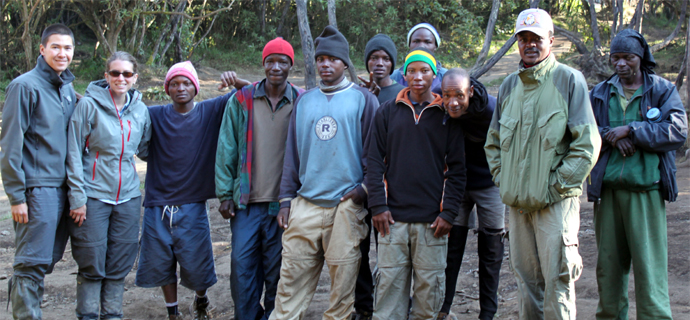
“He who climbs upon the highest mountains laughs at all tragedies, real or imaginary.”
-Nietzsche
|
